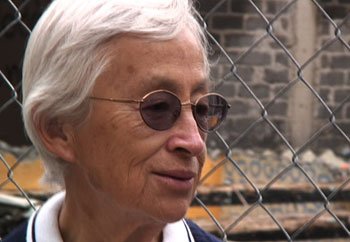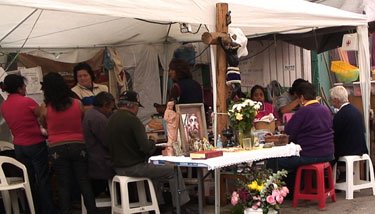The Narco News Bulletin |
August 15, 2018 | Issue #66 |
narconews.com - Reporting on the Drug War and Democracy from Latin America |
|
When Mexico City mayor Marcelo Ebrard and his government announced its plan to build a private superhighway from the south of the city to the country's bustling and affluent Santa Fe financial district in the west, they didn't have a plan for an organized resistance arising from the residents of La Malinche, a colonia that is set to be destroyed by the construction.
 Sister Maria Teresa: "More than anything we want to stop this death project." Photo: D.R. 2010 Sebastian Kolendo |
Located outside of Mexico City's subway system in the southwest, La Malinche is a neighborhood of housing projects and buildings that crawl up a steep incline to a hill that overlooks the city. The narrow streets leading up to the hill bend frequently, giving the impression of a maze, and on the walls in the colonia there are spray painted slogans that proclaim "No to the superhighway!" and curse the city's mayor.
Ebrard first announced his intention to build the superhighway in April 2008. Two years later, on April 6, 2010, La Malinche residents began to receive eviction orders delivered from the Mexico City government, targeting 51 apartment buildings and housing lots.
The government offered between $400,000 to $1.2 million pesos ($30,600 - $91,800US) to the owners of the units, but that didn't mean much for the more than 1,300 people who were forced to leave their homes. Neighbors say that the owners were told that if they didn't take the money, they'd get nothing and still lose their property. "Sometimes inside the houses there were up to 14 families," says Sister María Teresa, a nun at the Del sagrado corazón de Jesús Catholic church in the colonia. Some of the residents received a portion of the money from the property owners. Others got nothing.
Two months later in June, the government began to carry out the evictions on the residents who hadn't already left, while dozens of city police waited outside of the construction zone to enforce the eviction orders, if necessary. Soon after, work crews came in and took sledgehammers to the housing units, leaving blocks of wreckage in their path. The buildings are skeletal structures now, with giant holes torn through their walls and ceilings, as if a bomb had gone off nearby. What is left of the buildings now resembles what could easily be mistaken for a war zone. "We're sad, and we want justice to be done, but more than anything we want to stop this death project," Sister María Teresa says.
 Ramón Hernández Hernández: "This area makes much of the water that maintains the groundwater for the city." Photo: D.R. 2010 Sebastian Kolendo. |
"Why did we decide to camp?" says Rafael Martínez, one of the leaders organizing the front and the sit-in. "Because the laws no longer protect us...We are defenseless." Now the plantones remain, stopping the construction, and with it the government's plans to build a massive superhighway to what is considered to be Mexico's corporate headquarters. The neighbors have organized themselves to take shifts guarding the plantones, which are located on two separate and adjacent blocks. There are couches for residents to sleep on, and tarps provide shelter from the daily rains that fall in the city. There's also a makeshift communal kitchen for those staying in the demolition zone, which on a recent day served lentil soup, beef tacos with nopal cactus, and water.
The Ebrard administration and officials with the government of Magdalena Contreras (a delegación in Mexico City's government system, similar to a borough in New York), where La Malinche is located, have refused to sit down with residents and talk about possible solutions, according to residents. Behind the scenes there are lingering questions. Why build a privately-owned highway cutting across the city when there are alternatives that are less expensive and destructive? OHL group, one of Spain's top four construction corporations, is building the project, and will charge an unspecified toll amount to each driver on the road for the next 35 years.
 Residents of the town of La Malinche have successfully blockaded highway construction since July 26. Photo: D.R. 2010 Sebastian Kolendo |
Other residents suspect that the superhighway is a project to secure Ebrard's political legacy with Mexico's liberal Party of the Democratic Revolution, and perhaps for future presidential aspirations. Others think that Ebrard and his backers are trying to turn colonias like La Malinche into another, more gentrified financial district. "We believe that they're going to make this area into a new Santa Fe," says Ramón Hernández Hernández, who has lived in La Malinche for 40 years. "The soil of this part of Magdalena Contreras is very strong, fertile, and there is plenty of water."
There are environmental concerns, too. La Malinche is located along what is called the Magdalena river. Neighbors and numerous environmental scientists both fear what could happen if the river were to become contaminated. An independent Environmental Office of Zoning report found deficiencies in the environmental impact statement that was presented by OHL on the superhighway, including findings that the corporation failed to provide specific compensation measures for damage that will be done to the banks of the river during the construction. The last mayor of Mexico City, Andrés Manuel López Obrador, had recommended halting the project due to environmental concerns.
"This area makes much of the water that maintains the groundwater for the city," says Hernández Hernández, while pointing to the river near the hill. "The superhighway is going to break the ecology and groundwater. Without this area, the city will suffer more."
Residents of La Malinche recall how their parents and grandparents came to the colonia, and how they built the neighborhood from the ground up. It was the residents who decades ago built many of the buildings that are now set to be torn down. They constructed the church in the 1970s, and they planted the trees that now make a forest on the top of the hill, which the superhighway is expected to plow through.
 Map indicating the location of the La Malinche neighborhood that is blockading Mexico's City's planned superhighway. |
"Sometimes people make fun of us...." says Socorro Méndez, who helps cook the food for the plantones. "They say that we have nothing to do and we're just unruly. But this is the beginning of the destruction of all of Magdalena Contreras, not only of La Malinche. "
The city government is continuing with its plans to build the private highway. Barred from La Malinche, construction crews and their machines have already begun work in La Angostura, a colonia located on the opposite side of the hill, where residents have been forced to leave their homes. Neighbors don't want to end up like the people in La Angostura, and they don't want to see the government and a foreign corporation ruin what took their families decades to build. "Our parents and grandparents fought so that we can be talking here," says José Lopez Perez, 24, who helps guard one of the plantones. "Today, now it's we young people's turn to fight for this place."